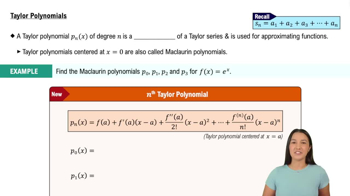What change of variables would you use for the integral ∫(4 - 7x)^(-6) dx?
Table of contents
- 0. Functions7h 54m
- Introduction to Functions16m
- Piecewise Functions10m
- Properties of Functions9m
- Common Functions1h 8m
- Transformations5m
- Combining Functions27m
- Exponent rules32m
- Exponential Functions28m
- Logarithmic Functions24m
- Properties of Logarithms36m
- Exponential & Logarithmic Equations35m
- Introduction to Trigonometric Functions38m
- Graphs of Trigonometric Functions44m
- Trigonometric Identities47m
- Inverse Trigonometric Functions48m
- 1. Limits and Continuity2h 2m
- 2. Intro to Derivatives1h 33m
- 3. Techniques of Differentiation3h 18m
- 4. Applications of Derivatives2h 38m
- 5. Graphical Applications of Derivatives6h 2m
- 6. Derivatives of Inverse, Exponential, & Logarithmic Functions2h 37m
- 7. Antiderivatives & Indefinite Integrals1h 26m
- 8. Definite Integrals4h 44m
- 9. Graphical Applications of Integrals2h 27m
- 10. Physics Applications of Integrals 3h 16m
- 11. Integrals of Inverse, Exponential, & Logarithmic Functions2h 34m
- 12. Techniques of Integration7h 41m
- 13. Intro to Differential Equations2h 55m
- 14. Sequences & Series5h 36m
- 15. Power Series2h 19m
- 16. Parametric Equations & Polar Coordinates7h 58m
7. Antiderivatives & Indefinite Integrals
Indefinite Integrals
Problem 8.1.36
Textbook Question
7–64. Integration review Evaluate the following integrals.
36. ∫ (t³ - 2) / (t + 1) dt
 Verified step by step guidance
Verified step by step guidance1
Step 1: Begin by analyzing the integrand (t³ - 2) / (t + 1). Since the degree of the numerator (t³) is higher than the degree of the denominator (t), perform polynomial long division to simplify the expression.
Step 2: Divide t³ by t + 1. The first term of the quotient is t². Multiply t² by (t + 1), subtract the result from the numerator, and repeat the process until the degree of the remainder is less than the degree of the denominator.
Step 3: After completing the polynomial division, express the integrand as the sum of the quotient and the remainder divided by (t + 1). The integral will now be in the form ∫(quotient + remainder / (t + 1)) dt.
Step 4: Split the integral into separate terms: ∫(quotient) dt + ∫(remainder / (t + 1)) dt. Evaluate each term individually. For the first term, integrate the polynomial quotient term by term using the power rule: ∫tⁿ dt = (tⁿ⁺¹) / (n + 1).
Step 5: For the second term, ∫(remainder / (t + 1)) dt, use substitution if necessary. Let u = t + 1, then du = dt. Rewrite the integral in terms of u and solve. Combine the results from both integrals to express the final solution.
 Verified video answer for a similar problem:
Verified video answer for a similar problem:This video solution was recommended by our tutors as helpful for the problem above
Video duration:
4mPlay a video:
Was this helpful?
Key Concepts
Here are the essential concepts you must grasp in order to answer the question correctly.
Integration
Integration is a fundamental concept in calculus that involves finding the integral of a function, which represents the area under the curve of that function on a given interval. It is the reverse process of differentiation and can be used to calculate quantities such as total distance, area, and volume. Understanding the rules and techniques of integration, such as substitution and integration by parts, is essential for solving integral problems.
Recommended video:

Integration by Parts for Definite Integrals
Polynomial Division
Polynomial division is a method used to divide one polynomial by another, similar to long division with numbers. In the context of integrals, it is often necessary to simplify the integrand (the function being integrated) by dividing polynomials to make the integration process easier. This technique helps to express the integrand in a form that can be integrated term by term.
Recommended video:

Taylor Polynomials
Definite vs. Indefinite Integrals
Integrals can be classified as definite or indefinite. An indefinite integral represents a family of functions and includes a constant of integration, while a definite integral calculates the net area under the curve between two specific limits. Understanding the difference is crucial for correctly interpreting the results of integration problems and applying the appropriate techniques.
Recommended video:

Definition of the Definite Integral

 5:04m
5:04mWatch next
Master Introduction to Indefinite Integrals with a bite sized video explanation from Patrick
Start learningRelated Videos
Related Practice
Textbook Question
15
views
